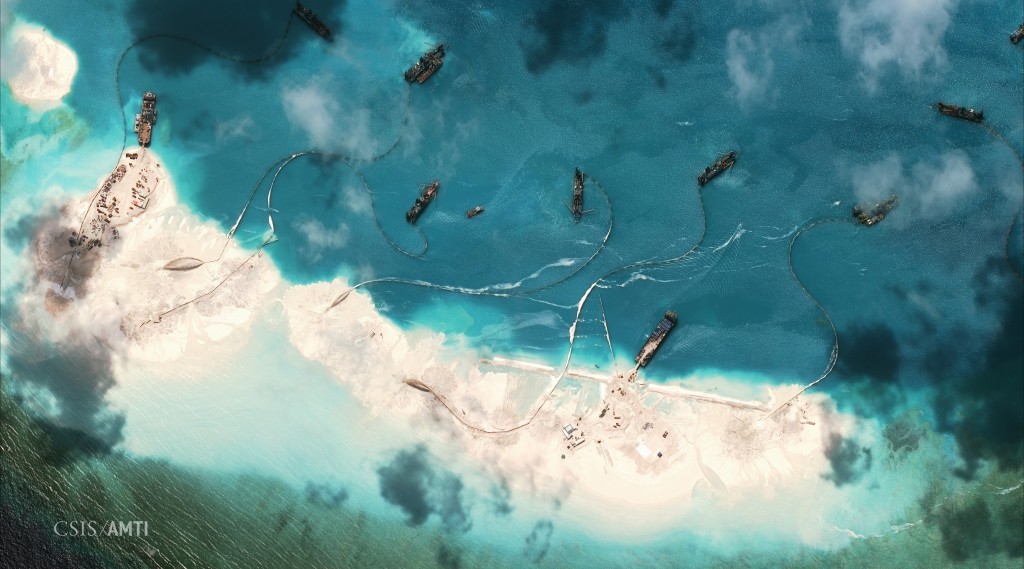PH envoy to UN: Sea row a global concern

THE reclamation activities of China in Panganiban (Mischief) Reef, an area within the Philippines’ exclusive economic zone in the disputed West Philippine Sea (South China Sea), has progressed in a few months, latest satellite images showed.
As the Philippines marked Independence Day on Friday, the United Nations was listening to the country’s call for an expression of global concern over China’s massive land reclamation in the South China Sea.
Speaking at the annual meeting of State Parties to the UN Convention on the Law of the Sea (Unclos) at UN headquarters in New York, Philippine Permanent Representative to the United Nations Lourdes Yparraguirre said China’s massive land reclamation activities to build artificial islands in the South China Sea should concern the entire international community.
“[China’s island-building] threatens the integrity of the convention, our constitution for the oceans,” Yparraguirre said, referring to the Unclos, which 167 countries, including the Philippines and China, have signed.
The Unclos “defines the rights and responsibilities” of the signatories “with respect to the use of the world’s oceans, and establishes guidelines for businesses, the environment and the management of marine natural resources,” the Department of Foreign Affairs (DFA) said Sunday.
In her speech, Yparraguirre cited instances of China’s violations of Philippine territory and sovereignty that deprived the country of its rights to its exclusive economic zone (EEZ).
Article continues after this advertisementShe said that in 2012, China reneged on a mutual agreement to withdraw naval presence from Panatag Shoal (Scarborough Shoal), located 223 kilometers west of Luzon, well within the Philippines’ 370-km EEZ, and 1,440 km southeast of the nearest Chinese coast.
Article continues after this advertisementTo this day, China controls the shoal, barring Filipino fishermen from their traditional fishing grounds there, she said.
Conduct of claimants
Yparraguirre said that by its large-scale reclamation work in the South China Sea, China also violated the 2002 Association of Southeast Asian Nations-China Declaration on the Conduct of Parties in the South China Sea, the Convention on Biological Diversity, and the Convention on International Trade in Endangered Species of Wild Fauna and Flora.
“To undertake this … ocean filling or reclamation [China] … has had to dredge out and pulverize entire systems of coral reefs that took many centuries to grow, reducing them [to] landfill, and thus devastating the already fragile marine ecosystem and biodiversity of the region by irreparably destroying the habitat of depleted, threatened or endangered species and other forms of marine life,” she said.
Citing data from marine experts, she said China’s destruction of coral reef systems in the South China Sea and their transformation into 800 hectares of landfill had resulted in an estimated economic loss of $281 million annually.
“There should be no attempt to assert territorial or maritime claims through intimidation, coercion or force, including through unilateral and aggressive action such as massive, large-scale land reclamation. There should be no pattern of forcing change in the status quo in order to advance a [claim] of undisputed sovereignty over nearly the entire South China Sea,” Yparraguirre said.
PH-claimed reefs
Recent satellite photos showed Chinese land reclamation at Philippine-claimed reefs in the Spratly archipelago, including Mabini (Johnson South), McKennan (Hughes), Panganiban (Mischief), Calderon (Cuarteron), Gavin (Gaven) and Kagitingan (Fiery Cross) reefs.
The photos also showed what appeared to be barracks, port facilities and an airstrip under construction, raising fears that China intends to use the artificial islands for military purposes.
Yparraguirre said China was building artificial islands at the reefs to change the features in the area ahead of a ruling from the UN arbitral tribunal on the Philippines’ petition to nullify Beijing’s claim to almost all of the 3.5-million-square-kilometer South China Sea.
Besides the Philippines, Brunei, Malaysia, Vietnam and Taiwan also claim territories in the South China Sea.
The United States, which is rebalancing its naval forces to the Asia-Pacific region, has called for an “immediate and lasting” halt to China’s island-building, warning that it is escalating tensions and undermining peace and stability in the region.
On June 10, Yparraguirre, speaking in a forum organized by the Philippines on the sidelines of the Unclos meeting, said the South China Sea was “already an environmental crisis” and reminded the signatories to the convention that they all shared the duty to protect and preserve the marine environment.
Edgardo Gomez, professor emeritus at the University of the Philippines Marine Science Institute and National Scientist of the Philippines, told the forum that the annual loss of $281 million due to the destruction of coral reefs in the disputed areas affected the Philippines, Malaysia, Indonesia, Vietnam and China.
The DFA said Gomez “applied calculations of ecological economics” to arrive at the figure.
Gomez called for a stop to the destruction of coral reefs, as well as to the exploitation of endangered species and overfishing and destructive fishing in the South China Sea.
‘Peace park’
Another expert who addressed the forum, Youna Lyons, senior research fellow in the Ocean and Policy Program of the Center for International Law of the National University of Singapore, proposed a moratorium on further development and dredging to build new features in the South China Sea “in order to save what can be saved.”
Lyons also proposed the establishment of a “peace park,” as suggested by marine science experts, focusing on a representative network of shallow features in the Spratly archipelago in the middle of the South China Sea.
RELATED STORIES
Obama to China: Stop throwing elbows
Philippines, US to set up South China Sea defense line
RELATED VIDEOS